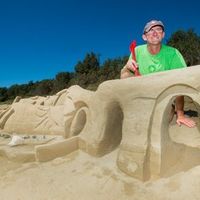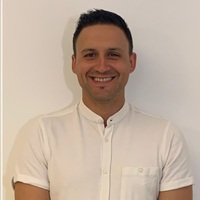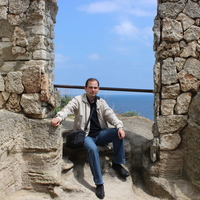Drs. Mark Beumer (3 november 1978) is an ancient historian and ritual scholar and currently working as a PhD-Candidate at Charles University, where he conducts research about the levels of change and continuity of temple sleep/incubation within the context of Christian transformation in Late Antiquity. In his dissertation, he focusses on the Roman Empire, Roman Egypt and Roman Greece, especially deities as Asklepios & Hygieia, Sarapis & Isis, Amphiaraos, and healing saints like Kosmas & Damianos, Demetrios, Thekla and Therapon. Mark is vice-president of Medisch-historische Club D. de Moulin at Nijmegen.
Mark is looking through the lens of Ritual Studies, founded by prof. dr. Ronald Grimes. Within Ritual Studies, the consensus is that rituals are always changing. This is called ritual dynamics. However, how quick rituals change is subject for debate. In his dissertation, Mark applies the ritual theory of ecological anthropologist Roy Rappaport: the concept of adaptation (homeostasis, self-regulation, reflexitivy).
ORCID: https://orcid.org/0000-0002-2033-9920
https://hcommons.org/members/mark1978/
Main publications:
(Article) 'A Woman’s Touch. Hygieia, Health and Incubation', in: Journal of History of Sciences and Technology/DVT - Dejiny ved a techniky, Volume LV – Number 1-2 (2022) 25-55.
(Article) 'The Foundation of Anthropology to Ritual Studies', in: Journal of Ritual Studies 34.2 (2020). DOI: 10.1093/acrefore/9780199340378.013.21
(Article) 'Asklepios en de 'pest van Athene'', in: Cahiers Geschiedenis van de Geneeskunde en Gezondheidszorg 15 (2021) (peer reviewed)
(Article) 'Hygieia. Identity, Cult and Reception', in: Kleio-Historia, nr. 3. (2016) 5-24 (peer reviewed)
(Book) Hygieia. Godin of Personificatie? (Boekscout, 2e druk 2016 [2015]).
(Book) Welke rol speelt de Griekse godsdienst bij Aischulos en Euripides (GlobeEdit 2016).
Education:
Master of Arts Teaching History and Civics 1st Degree (30 januari 2009)
Master of Arts in History, specialization Ancient History (25 juni 2008)
Bachelor of Education in History and Civics 2nd Degree (28 juni 2006)
Pharmacist Assistant, specialization Immunology and Hospital Pharmacy (2002).
Fashion Advisor (11 april 2001)
Supervisors: Prof. Assoc. T. Alušík Ph.D.
Mark is looking through the lens of Ritual Studies, founded by prof. dr. Ronald Grimes. Within Ritual Studies, the consensus is that rituals are always changing. This is called ritual dynamics. However, how quick rituals change is subject for debate. In his dissertation, Mark applies the ritual theory of ecological anthropologist Roy Rappaport: the concept of adaptation (homeostasis, self-regulation, reflexitivy).
ORCID: https://orcid.org/0000-0002-2033-9920
https://hcommons.org/members/mark1978/
Main publications:
(Article) 'A Woman’s Touch. Hygieia, Health and Incubation', in: Journal of History of Sciences and Technology/DVT - Dejiny ved a techniky, Volume LV – Number 1-2 (2022) 25-55.
(Article) 'The Foundation of Anthropology to Ritual Studies', in: Journal of Ritual Studies 34.2 (2020). DOI: 10.1093/acrefore/9780199340378.013.21
(Article) 'Asklepios en de 'pest van Athene'', in: Cahiers Geschiedenis van de Geneeskunde en Gezondheidszorg 15 (2021) (peer reviewed)
(Article) 'Hygieia. Identity, Cult and Reception', in: Kleio-Historia, nr. 3. (2016) 5-24 (peer reviewed)
(Book) Hygieia. Godin of Personificatie? (Boekscout, 2e druk 2016 [2015]).
(Book) Welke rol speelt de Griekse godsdienst bij Aischulos en Euripides (GlobeEdit 2016).
Education:
Master of Arts Teaching History and Civics 1st Degree (30 januari 2009)
Master of Arts in History, specialization Ancient History (25 juni 2008)
Bachelor of Education in History and Civics 2nd Degree (28 juni 2006)
Pharmacist Assistant, specialization Immunology and Hospital Pharmacy (2002).
Fashion Advisor (11 april 2001)
Supervisors: Prof. Assoc. T. Alušík Ph.D.
less
Related Authors
Hedvig von Ehrenheim
Stockholm University
Ildiko Csepregi
Universidade de Vigo
Matthew P.J. Dillon
University of New England - Australia
Ángel Narro
Universitat de València
Cezar-Ivan Coliță
University of Bucharest
Alice-Mary Talbot
Dumbarton Oaks
Klaniczay Gabor
Central European University
Aneta Liwerska-Garstecka
Adam Mickiewicz University in Poznań
Stavroula Constantinou
University of Cyprus
Grigori Simeonov
University of Vienna
InterestsView All (308)










Uploads
Peer reviewed papers by Mark Beumer
On page 52 we read:
First, we have a votive relief of pentelic marble (ca. 400 BC), found behind
the theatre of Piraeus, which could have been the location of the Asklepieion at
Piraeus.136 We see Asklepios bending over a lying woman, which is covered by a
skin. On the left, we see adorants with a child, possible relatives of the woman.
Leventi argues, that on the right, we see Hygieia resting on her left leg, although
this figure could also be identified as Epione or Iaso. Leventi identifies this scene
as an incubation scene.137 Renberg disagrees with Leventi, keeping this question
unanswered.138
This has to be:
First, we have a votive relief of pentelic marble (ca. 400 BC), found behind
the theatre of Piraeus, which could have been the location of the Asklepieion at
Piraeus.136 We see Asklepios bending over a lying woman, which is covered by a
skin. On the left, we see adorants with a child, possible relatives of the woman.
Leventi argues, that on the right, we see Hygieia resting on her left leg, although
this figure could also be identified as Panakeia or Iaso, according to Holtzmann. Leventi identifies this scene as an incubation scene.137 Renberg agrees with Leventi, describing her as Hygieia.138
Also, the footnotes are not correct concerning to reference to the pages. Please, mind the right annotation below.
137. R 13. Piraeus Museum 405 (Plate 15) in Leventi., Hygieia, 133-134.
138. Figure 29 Cat. No. Ask.-Peir.1 (Peiraeus Mus. 405) in Renberg, Where Dreams May
Come, 636.
The footnotes have been restored.
My sincere apologies.
Volumes by Mark Beumer
Chapters by Mark Beumer
Papers by Mark Beumer
On page 52 we read:
First, we have a votive relief of pentelic marble (ca. 400 BC), found behind
the theatre of Piraeus, which could have been the location of the Asklepieion at
Piraeus.136 We see Asklepios bending over a lying woman, which is covered by a
skin. On the left, we see adorants with a child, possible relatives of the woman.
Leventi argues, that on the right, we see Hygieia resting on her left leg, although
this figure could also be identified as Epione or Iaso. Leventi identifies this scene
as an incubation scene.137 Renberg disagrees with Leventi, keeping this question
unanswered.138
This has to be:
First, we have a votive relief of pentelic marble (ca. 400 BC), found behind
the theatre of Piraeus, which could have been the location of the Asklepieion at
Piraeus.136 We see Asklepios bending over a lying woman, which is covered by a
skin. On the left, we see adorants with a child, possible relatives of the woman.
Leventi argues, that on the right, we see Hygieia resting on her left leg, although
this figure could also be identified as Panakeia or Iaso, according to Holtzmann. Leventi identifies this scene as an incubation scene.137 Renberg agrees with Leventi, describing her as Hygieia.138
Also, the footnotes are not correct concerning to reference to the pages. Please, mind the right annotation below.
137. R 13. Piraeus Museum 405 (Plate 15) in Leventi., Hygieia, 133-134.
138. Figure 29 Cat. No. Ask.-Peir.1 (Peiraeus Mus. 405) in Renberg, Where Dreams May
Come, 636.
The footnotes have been restored.
My sincere apologies.
In 2022 heeft prof. dr. Lukken een nieuw deel van het Instituut voor Rituele en Liturgische Studies (IRiLiS) geschreven met als titel: De liturgische vernieuwing in Nederland na Vaticanum II.
Hierin besteedt hij tot mijn grote verrassing aandacht mijn artikel, waarover hij lovend spreekt, en aanbeveelt voor verder onderzoek. Ook geeft hij aan in te stemmen met mijn model over inculturatie/culturatie, waarvoor ik ook de beschouwingen van Martin Hoondert gebruikte. Uiteindelijk doopte ik dit model "Lukken-Hoondert-model". Prof. Lukken stelt echter voor om dit te hernoemen naar "Beumer-Hoondert-Lukken-model", een term die ik graag accepteer. Zie pagina 37-38.
Ik dank prof. dr. Lukken zeer hartelijk voor zijn vriendelijke woorden en beveel deze uitgave van harte aan.
Voor de geïnteresseerden hier de link naar dit artikel uit 2020: https://www.academia.edu/43697162/Beumer_2020_Gerard_Lukken_herzien_Een_pleidooi_voor_een_Lukken_Hoondert_model20200723_123334_7hw0hb
Carlos Noreña, University of California, Berkeley
This lecture argues that "Romanization" is still the best analytical concept to understand cultural change in the Roman Mediterranean. Highlighting the "scaling up" in various domains that empire triggered throughout the Mediterranean basin, it proposes that we should understand "Romanization" not in narrowly cultural terms (much less normative ones), but rather as the particular convergence of a set of cultural forms, the infrastructural power of the Roman state, and the replication of both at unprecedented scale. The very different path of cultural integration in the Qin and Han empires of early China will help to draw out the peculiar relationship between culture and power in the Roman world.
Carlos Noreña is a Professor of History, and Ancient History and Mediterranean Archaeology, at the University of California, Berkeley. His research focuses on the political and cultural history of the Roman empire; the historical geography of the Roman empire, especially in the west; and comparative empires. He is the author of Imperial Ideals in the Roman West (Cambridge, 2011) and editor, most recently, of A Cultural History of Western Empires: Antiquity (Bloomsbury, 2018). Current projects include a monograph on law and imperialism in the Roman Republic and an edited volume on the Atlantic façade of the Roman empire.
Lecture #2: Romans in Residence -- and the Mediterranean Which Resulted
Nicholas Purcell, University of Oxford
Outsider communities dotted the ancient Mediterranean world. They played a key role in shaping the consistencies of inter-community relations, and of the Mediterranean as a whole. From the second century BCE to the third CE, some of the most visible are labelled in Greek and Latin ‘Resident Romans’, and also often ‘people who do business’. We know some of their activities: since unusually, these inscriptions drew attention to the world of economic exchange (and even sometimes specifically to trade in unfree people). During the period such communities are attested, the Mediterranean became more and more firmly subordinated to Roman political, social and economic power. This ‘Roman diaspora’ is naturally of considerable interest for studying textures of interaction within that hegemony. Long neglected, it is now receiving more, and productive, attention. Here I want to ask about how claims of identity relating, like this, to the ruling power, affected the map of community-memberships across the Mediterranean world. Diasporic Mediterranean communities of other periods, some hegemonic (Genoese or Venetian), some not (Syrian or Jewish) offer parallels (and contrasts).
Nicholas Purcell is the Camden Professor of Ancient History at Oxford, and works on ancient social, economic and cultural history. He has been interested throughout his career in how to write Mediterranean history in ways which pull together evidence from different periods, from prehistory to modernity, but especially the ancient and medieval Mediterraneans. That is the theme of his monograph of 2000, The Corrupting Sea: a study of Mediterranean History, written with the medievalist Peregrine Horden.
dominated by disciplines such as History, Archaeology and Classics. However, this field
has recently changed. New disciplines are now also joining this debate, such as Ritual
Studies, Dream Theory, Cognitive Science and Food Studies. In this presentation, Mark will explore these new fields and argue what added value these new perspectives offer to
this interesting debate that takes place in Late Antiquity (2nd-7th centuries).
Session Number: 528 , Cultures of Healing in Late Antiquity and the (Mostly) Early Middle Ages, I: Places and Spaces of Healing.
Date/Time: Tuesday 04 July 2023, 09.00-10.30 Format: In Person Session
Updated and corrected version: 28 juni 2021
Mark Beumer
5.1 De wereld wordt groter
5.2 Renaissance en het humanisme
5.3 De kerkhervorming
5.4 Uit de Opstand een Republiek geboren
In deze lange PowerPoint is uitgebreid aandacht voor de Eerste Wereldoorlog en dan met name de Buiteneuropese geschiedenis die vaak wordt vergeten alsook zaken als de Spaanse griep.
Met behulp van twee lesmethoden VWO (Feniks en Sprekend Verleden) en wetenschappelijke literatuur is deze PowerPoint gemaakt.
1. Slavernij, een geschiedenis.
2. Levende Grafiek. Trans-Atlantische slavenhandel 1600-1850.
3. Beelden ter discussie.
4. Burgerschapsvorming en slavernij.
5. Burgerschapsvorming en slavernij: poster.
Via de link https://markbeumer.eu/lessenserie-slavernij kunt u de lessen downloaden
Hieronder kunt u de lessen downloaden.
Les 1 Slavernij, een geschiedenis (Word)
Les 1 Slavernij, een geschiedenis (PowerPoint)
Les 2 Levende Grafiek. Trans-Atlantische slavenhandel 1600-1850 (Word)
Les 3 Beelden ter discussie (Word)
Les 4 Burgerschapsvorming en slavernij (Word)
Les 4 Burgerschapsvorming en slavernij. Slavernij en jij! (PowerPoint)
Les 5 Burgerschapsvorming en slavernij. Poster (Word)
Lesbrief Geschiedenis van de Nederlandse slavernij
Literatuur, websites, herinneringsplaatsen, audiovisueel materiaal m.b.t. slavernij
De geschiedenis van Rabobank Rijk van Nijmegen aan het Keizer Karelplein is een breed omvattende geschiedenis van een perceel dat in een brede historische context te plaatsen is. De geschiedenis van Nijmegen, het bank-en kredietwezen en planologie is nauw verweven met de grote sociaal-economische geschiedenis van Nijmegen en Nederland.